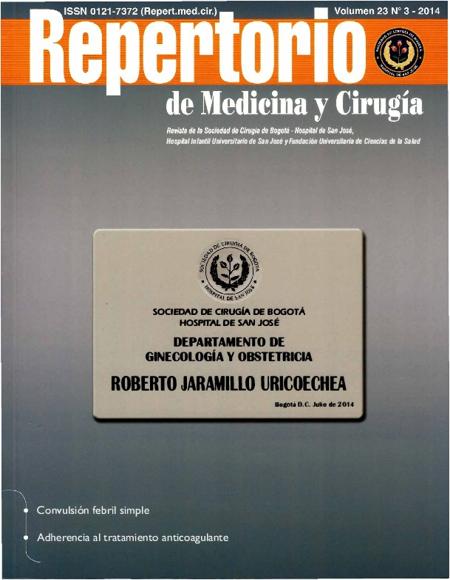Aislamientos bacterianos en apendicitis aguda
Bacterial isolations in acute appendicitis
Cómo citar
Descargar cita
Esta obra está bajo una licencia internacional Creative Commons Atribución-NoComercial-CompartirIgual 4.0.
Mostrar biografía de los autores
La apendicitis aguda es una patología de interés a nivel mundial con una incidencia de 100 por cada 100.000 personas/año, reportada a nivel europeo y norteamericano. La fisiopatología en forma experimental se ha relacionado con un proceso obstructivo, que evoluciona a estado isquémico favoreciendo la translocación bacteriana, por lo cual se han relacionado los distintos microorganismos como factor de importancia en el desarrollo de sus complicaciones. Se realizó una revisión de los estudios publicados en PubMed en los últimos veinte años con términos MeSH appendicitis, bacteria y etiology donde se documento la E. coli como el germen bacteriano más común y B. fragilis como un anaerobio frecuente. No se encontraron estudios que reporten perfiles de sensibilidad a resistencia antibiótica.
Visitas del artículo 867 | Visitas PDF 6611
Descargas
1. Ohmann C, Franke C, Kraemer M, Yang Q. Status report on epidemiology of acute appendicitis. Chirurg. 2002 Aug; 73(8): 769-76.
2. Wangensteen OH, Dennis C. Experimental proof of the obstructive origin of appendicitis in man. Ann Surg. 1939; 110: 629-47.
3. Boley SJ, Agrawal GP, Warren AR, Veith FJ, Levowitz BS, Treiber W, et al. Pathophysiologic effects of bowel distention on intestinal blood flow. Am J Surg. 1969; 117: 228-34.
4. Bennion RS, Wilson SE, Serota AI, Williams RA. The role of gastrointestinal microflora in the pathogenesis of complications of mesenteric ischemia. Rev Infect Dis. 1984;6: 132-8.
5. Humes D, Simpson J. Acute appendicitis. BMJ. 2006 sep 9; 333(7567): 530-34.
6. Lamps LW. Infectious causes of appendicitis. Infect Dis Clin North Am. 2010 Dec; 24(4):995-1018.
7. Davies HO, Alkhamesi NA, Dawson PM. Peritoneal fluid culture in appendicitis: review in changing times. Int J Surg. 2010; 8(6):426-9.
8. Bilik R, Burnweit C, Shandling B. Is abdominal cavity culture of any value in appendicitis?. Am J Surg. 1998 Apr; 175(4):267-70.
9. Solomkin JS, Mazuski JE, Bradley JS, Rodvold KA, Goldstein EJ, Baron EJ, et al. Diagnosis and management of complicated intra-abdominal infection in adults and children: guidelines by the Surgical Infection Society and the Infectious Diseases Society of America. Clin Infect Dis. 2010 Jan 15; 50(2):133-64.
10. Ramírez Valderrama A, Carvajal Puyana A, Acosta Lozano J, Sánchez Toro CA, Espinosa Correa C, Baene Ferez I, et al. Antibióticos profilácticos en apendicitis aguda: evaluación de un protocolo. Rev Colom Cir. 2005; 20: 21-5.
11 Bhavnani SM, Rubino CM, Ambrose PG, Babinchak TJ, Korth-Bradley JM, Drusano GL. Impact of different factors on the probability of clinical response in tigecycline-treated patients with intra-abdominal infections. Antimicrob Agents Chemother. 2010 Mar; 54(3):1207-12.
12 Barie PS, Vogel SB, Dellinger EP, Rotstein OD, Solomkin JS, Yang JY, et al. A randomized, double-blind clinical trial comparing cefepime plus metronidazole with imipenem-cilastatin in the treatment of complicated intra-abdominal infections. Cefepime Intra-abdominal Infection Study Group. Arch Surg. 1997 Dec;1 32(12):1294-302.
13 Malangoni MA, Song J, Herrington J, Choudhri S, Pertel P. Randomized controlled trial of moxifloxacin compared with piperacillin-tazobactam and amoxicillin-clavulanate for the treatment of complicated intra-abdominal infections. Ann Surg. 2006 Aug; 244(2):204-11.
14 Oliva ME, Rekha A, Yellin A, Pasternak J, Campos M, Rose GM, et al. A multicenter trial of the efficacy and safety of tigecycline versus imipenem/cilastatin in patients with complicated intra-abdominal infections [Study ID Numbers: 3074A1-301-WW; ClinicalTrials.gov Identifier: NCT00081744].BMC Infect Dis. 2005;5:88.
15 Barboza E, Solomkin J, Goldstein EJ, del Castillo M, Alvarado R, Barboza A, et al. [New Beta-lactam agent in the treatment of intra-abdominal sepsis: double blind and randomized stage III study of ertapenem versus piperacillin/tazobactam]. Rev Gastroenterol Peru. 2003 Jul; 23(3):192-8.
16 Solomkin JS, Yellin AE, Rotstein OD, Christou NV, Dellinger EP, Tellado JM, et al. Ertapenem versus piperacillin/tazobactam in the treatment of complicated intraabdominal infections: results of a double-blind, randomized comparative phase III trial. Ann Surg. 2003 Feb; 237(2):235-45.
17 Cohn SM, Lipsett PA, Buchman TG, Cheadle WG, Milsom JW, O’Marro S, et al. Comparison of intravenous/oral ciprofloxacin plus metronidazole versus piperacillin/tazobactam in the treatment of complicated intraabdominal infections. Ann Surg. 2000 Aug; 232(2):254-62.
18 de Groot HG, Hustinx PA, Lampe AS, Oosterwijk WM. Comparison of imipenem/cilastatin with the combination of aztreonam and clindamycin in the treatment of intra-abdominal infections. J Antimicrob Chemother. 1993 Sep;32(3):491-500.
19 Wilson SE. Results of a randomized, multicenter trial of meropenem versus clindamycin/tobramycin for the treatment of intra-abdominal infections. Clin Infect Dis. 1997 Feb; 24 Suppl 2:S197-S206.
20 Brismar B, Malmborg AS, Tunevall G, Wretlind B, Bergman L, Mentzing LO, et al. Piperacillin-tazobactam versus imipenem-cilastatin for treatment of intraabdominal infections. Antimicrob Agents Chemother. 1992 Dec; 36(12):2766-73.
21 Salemis NS. Acute appendicitis presenting with Klebsiellapneumoniae septicemia due to bacterial translocation. Am J Emerg Med. 2009 Oct; 27(8):1023-4.
22 Yildiz M, Karakayali AS, Ozer S, Ozer H, Demir A, Kaptanoglu B. Acute appendicitis presenting with abdominal wall and right groin abscess: a case report. World J Gastroenterol. 2007 Jul 14; 13(26):3631-3.
23. Hale DA, Molloy M, Pearl RH, Schutt DC, Jaques DP. Appendectomy: a contemporary appraisal. Ann Surg. 1997 Mar; 225(3):252-61.
24 Clark JA, Keroack MA. Pneumococcal appendicitis in a man with HIV infection. N Engl J Med. 1993 Apr 29; 328(17):1282.
25 Welch WD, Southern PM, Jr., Schneider NR. Five cases of Haemophilussegnis appendicitis. J Clin Microbiol. 1986 Nov; 24(5):851-2.
26. Lau WY, Fan ST, Chu KW, Suen HC, Yiu TF, Wong KK. Randomized, prospective, and double-blind trial of new beta-lactams in the treatment of appendicitis. Antimicrob Agents Chemother. 1985 Nov; 28(5):639-42.
27. Allo MD, Bennion RS, Kathir K, Thompson JE Jr, Lentz M, Meute M, et al. Ticarcillin / clavulanate versus imipenem / cilistatin for the treatment of infections associated with gangrenous and perforated appendicitis. Am Surg. 1999 Feb; 65(2):99-104.
28. Kasatpibal N, Nørgaard M, Sørensen H, Schønheyder H, Jamulitrat S, Chongsuvivatwong V. Risk of surgical site infection and efficacy of antibiotic prophylaxis: a cohort study of appendectomy patients in Thailand. BMC Infect Dis. 2006, 6:111-117.













